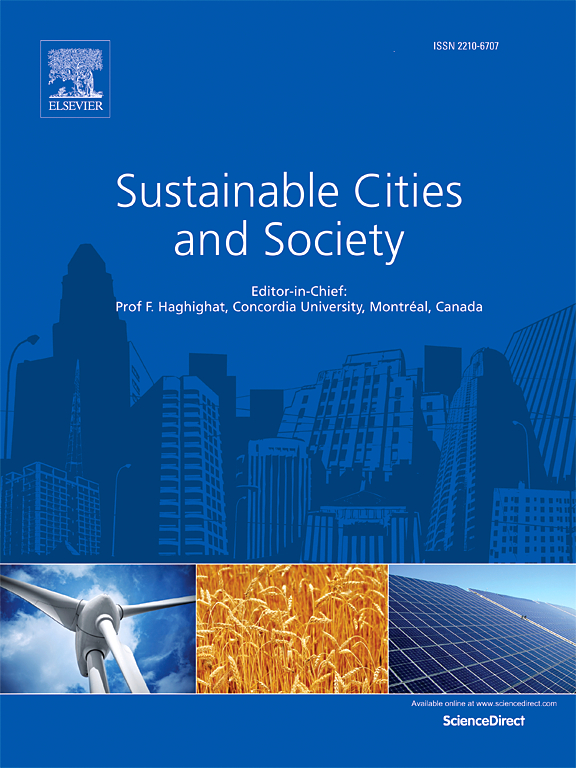Influence of environmental factors on land surface temperature and surface urban heat island. A cross-country analysis in Romania
IF 10.5
1区 工程技术
Q1 CONSTRUCTION & BUILDING TECHNOLOGY
引用次数: 0
Abstract
Environmental factors such as vegetation, albedo, building density and height play a crucial role in modeling and analysing Land Surface Temperature (LST) and understanding the Surface Urban Heat Island intensity (SUHII) through interactions between surface properties and energy fluxes. Monitoring and optimizing these factors allow cities to implement urban cooling strategies, such as expanding green spaces, using high-albedo materials, and creating water features, thus helping mitigate the impacts of climate change and enhancing thermal comfort for urban residents. This study investigates the relationship between LST and environmental factors, including albedo, vegetation (measured through indices such as Fcover, LAI, NDVI, and tree density), and built-up areas characterized by density, volume, surface area, and height. Additionally, we sought to identify the main environmental components that significantly contribute to either cooling or warming urban surfaces. The study covered 41 cities in Romania, and it is based on high-resolution satellite imagery, including Sentinel-2 for vegetation indices and albedo, satellite products for built-up area characteristics. The 1-km resolution Sentinel-3 SLSTR LST was subsequently enhanced to 20 m for increased accuracy of the results. The analysis covered the period 2018–2023, focusing on the summer season. This study provides valuable insights into how environmental factors shape urban temperature dynamics, offering a foundation for developing targeted strategies to reduce urban heat and improve city resilience against climate change impacts.
环境因子对地表温度和城市地表热岛的影响。罗马尼亚的一项跨国分析
植被、反照率、建筑密度和高度等环境因子在模拟和分析地表温度(LST)以及通过地表性质与能量通量之间的相互作用来理解地表城市热岛强度(SUHII)方面发挥着至关重要的作用。监测和优化这些因素有助于城市实施城市降温策略,如扩大绿地、使用高反照率材料和创造水景,从而有助于减轻气候变化的影响,提高城市居民的热舒适度。研究了地表温度与反照率、植被(通过Fcover、LAI、NDVI和树密度等指数测量)以及以密度、体积、表面积和高度为特征的建成区等环境因子的关系。此外,我们还试图确定对城市表面变冷或变暖有显著影响的主要环境成分。这项研究覆盖了罗马尼亚的41个城市,它基于高分辨率卫星图像,包括Sentinel-2的植被指数和反照率,以及建成区特征的卫星产品。1公里分辨率的Sentinel-3 SLSTR LST随后被增强到20米,以提高结果的精度。该分析涵盖了2018年至2023年期间,重点关注夏季。该研究为了解环境因素如何影响城市温度动态提供了有价值的见解,为制定有针对性的策略来减少城市热量和提高城市抵御气候变化影响的能力提供了基础。
本文章由计算机程序翻译,如有差异,请以英文原文为准。
求助全文
约1分钟内获得全文
求助全文
来源期刊

Sustainable Cities and Society
Social Sciences-Geography, Planning and Development
CiteScore
22.00
自引率
13.70%
发文量
810
审稿时长
27 days
期刊介绍:
Sustainable Cities and Society (SCS) is an international journal that focuses on fundamental and applied research to promote environmentally sustainable and socially resilient cities. The journal welcomes cross-cutting, multi-disciplinary research in various areas, including:
1. Smart cities and resilient environments;
2. Alternative/clean energy sources, energy distribution, distributed energy generation, and energy demand reduction/management;
3. Monitoring and improving air quality in built environment and cities (e.g., healthy built environment and air quality management);
4. Energy efficient, low/zero carbon, and green buildings/communities;
5. Climate change mitigation and adaptation in urban environments;
6. Green infrastructure and BMPs;
7. Environmental Footprint accounting and management;
8. Urban agriculture and forestry;
9. ICT, smart grid and intelligent infrastructure;
10. Urban design/planning, regulations, legislation, certification, economics, and policy;
11. Social aspects, impacts and resiliency of cities;
12. Behavior monitoring, analysis and change within urban communities;
13. Health monitoring and improvement;
14. Nexus issues related to sustainable cities and societies;
15. Smart city governance;
16. Decision Support Systems for trade-off and uncertainty analysis for improved management of cities and society;
17. Big data, machine learning, and artificial intelligence applications and case studies;
18. Critical infrastructure protection, including security, privacy, forensics, and reliability issues of cyber-physical systems.
19. Water footprint reduction and urban water distribution, harvesting, treatment, reuse and management;
20. Waste reduction and recycling;
21. Wastewater collection, treatment and recycling;
22. Smart, clean and healthy transportation systems and infrastructure;
 求助内容:
求助内容: 应助结果提醒方式:
应助结果提醒方式:


